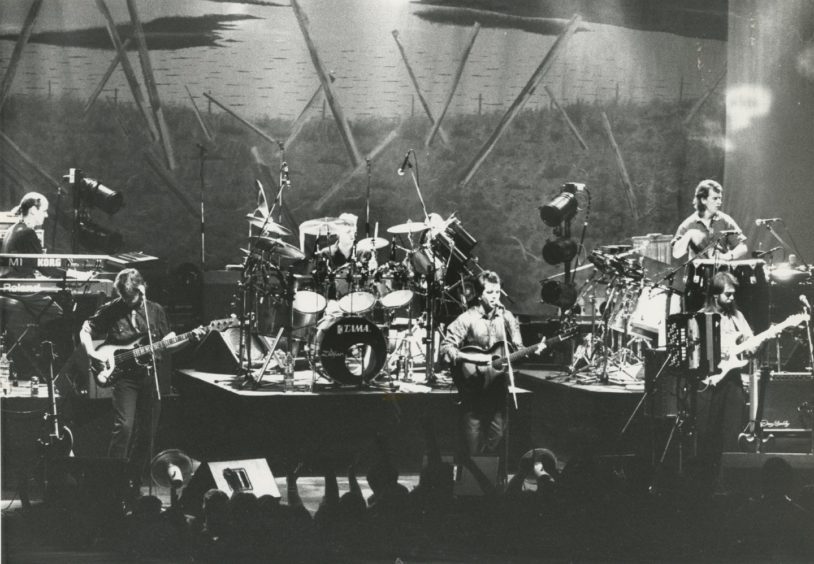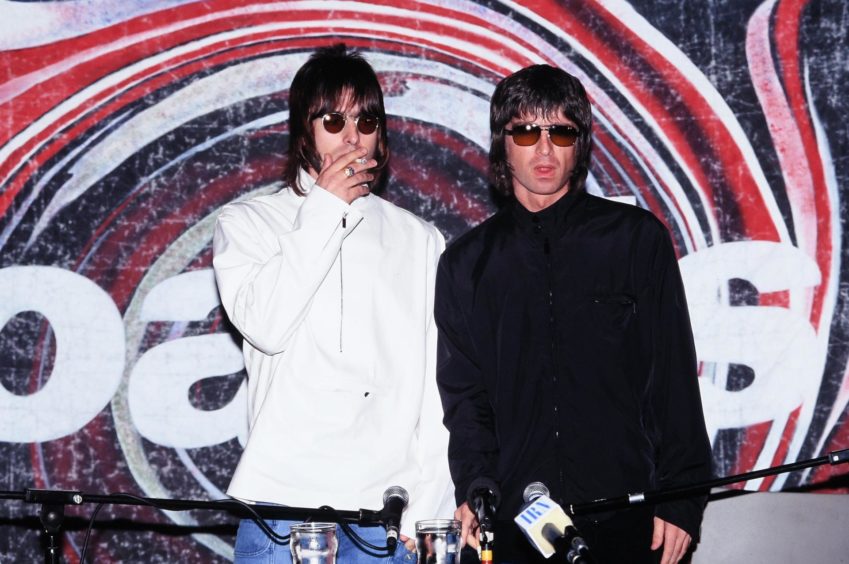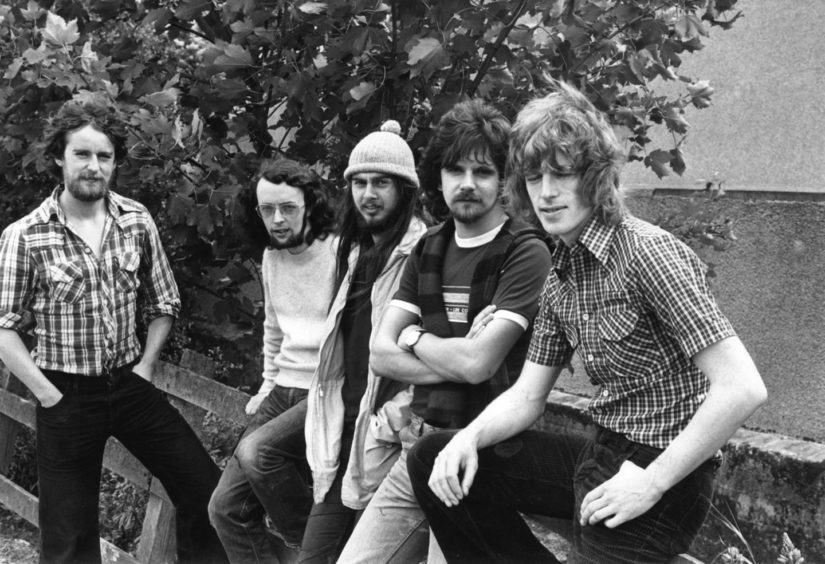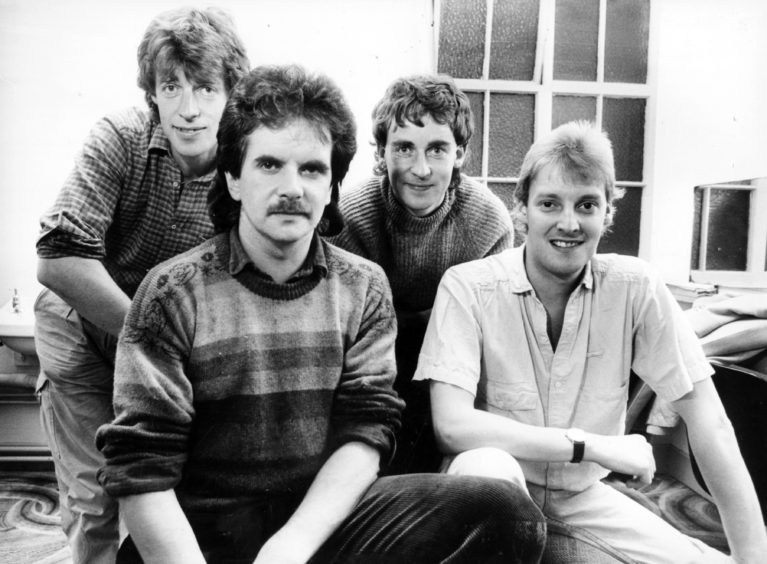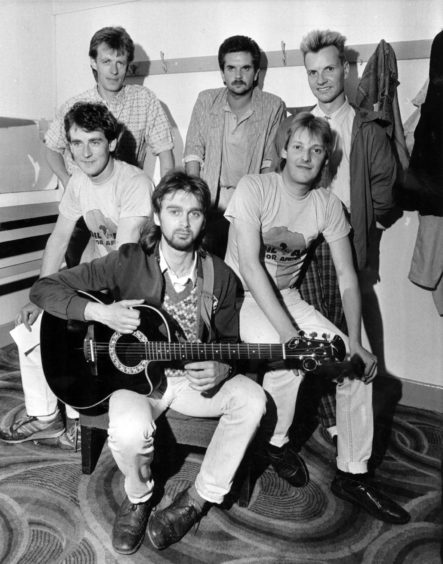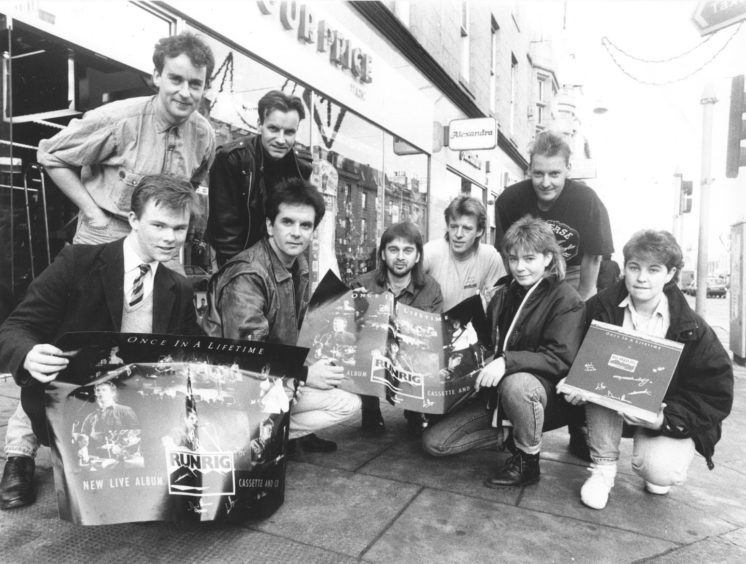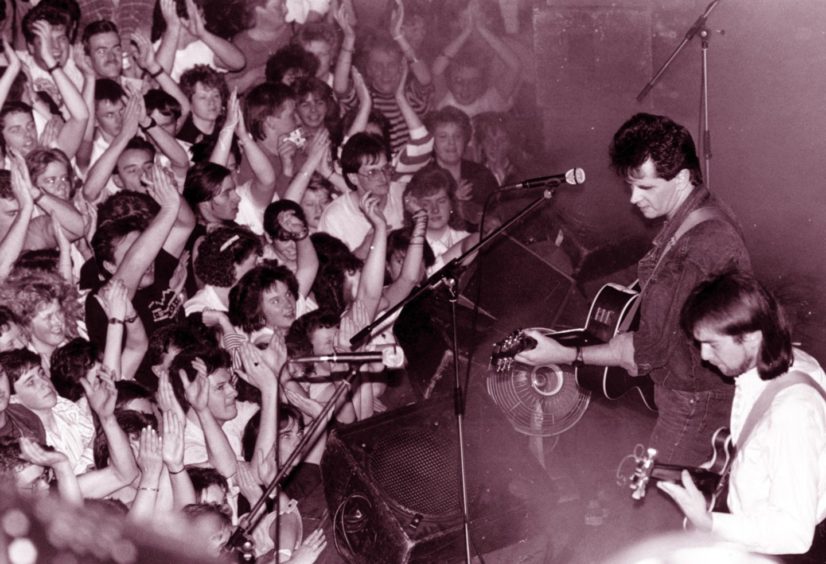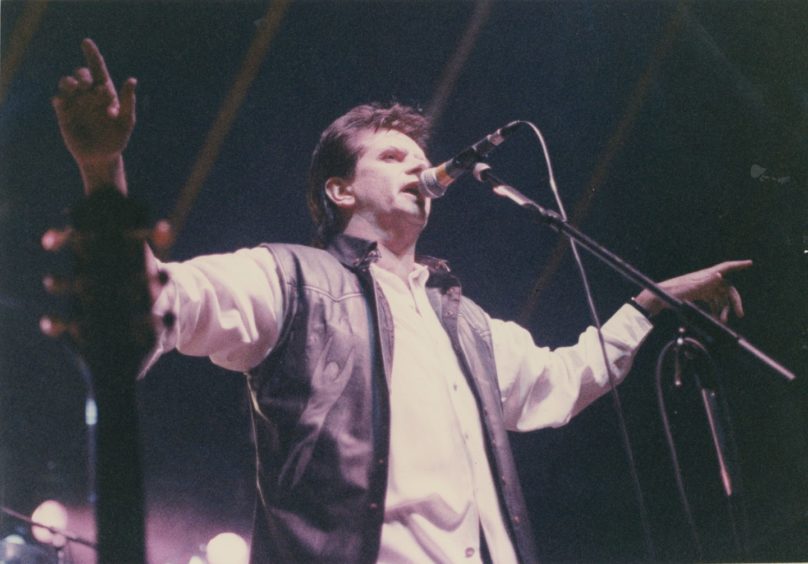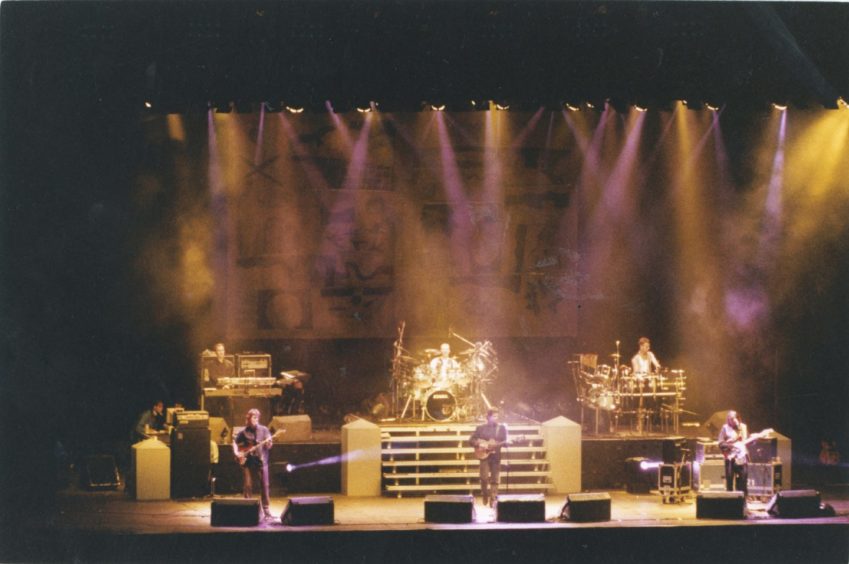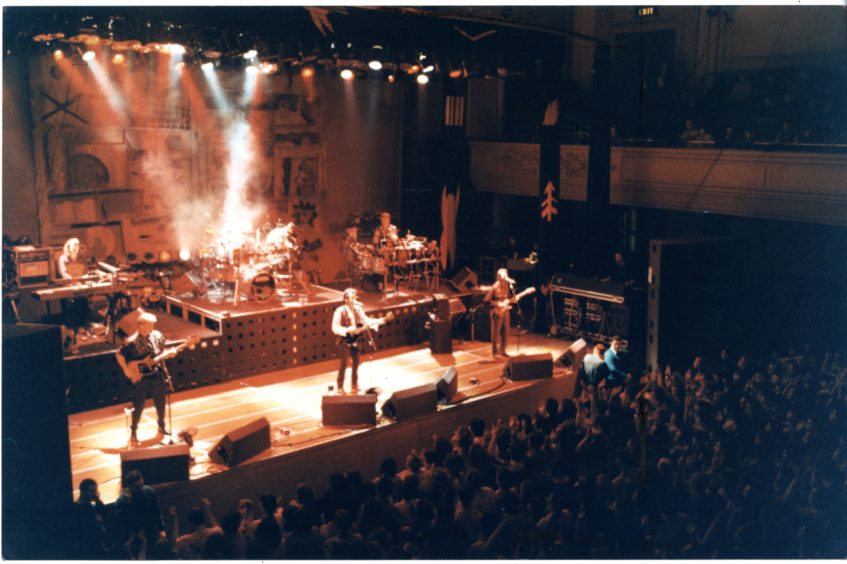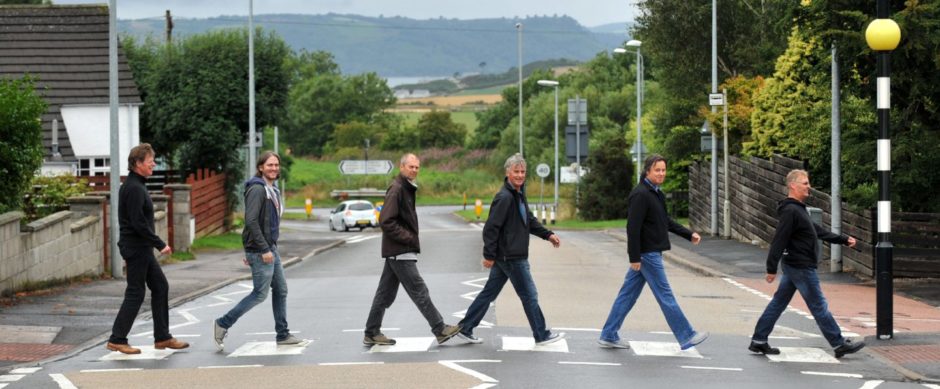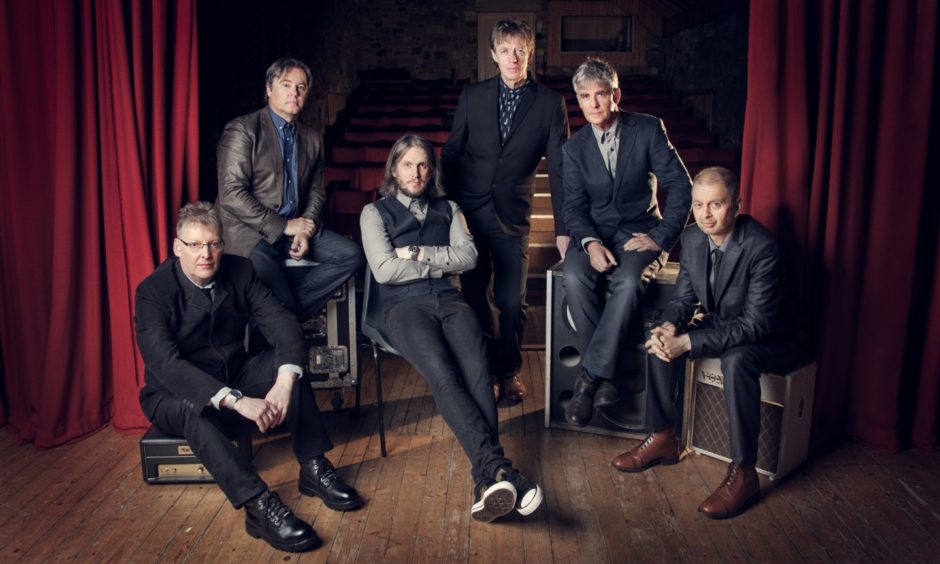When Runrig played Top Of The Pops alongside Diana Ross they were told not to make eye contact with or even look at the soul diva… so they had a dressing room wall-banging argy-bargy with rock bad boys Oasis instead.
“Oasis had the dressing room next door to us and they were playing a mix of Roll With It on repeat all the time, all throughout the afternoon and evening, to the point we were just fed up with it”, said Rory Macdonald, founder member of the iconic Scottish band, as was his brother Calum.
“So we started banging the wall and shouting ‘shut up’ and they started the same. We met them outside and we were both saying ‘what’s all that racket’… but it was all fun, just banter back.”
“The same time, Diana Ross was performing, but there was not a chance of banter with her, because we were told in advance that when she came in with her entourage, nobody was to look at her or make any eye contact. That was a totally different thing.
It’s one of many memories Rory has of Runrig’s astonishing career spanning 45 years from their early days as a Skye ceilidh dance band to their triumphant farewell concerts – The Last Dance – at Stirling Castle in front of 50,000 over two unforgettable nights in 2018.
Celebration of band’s career
That career is being celebrated in a special weekend of programmes about Runrig on BBC Alba from Friday, charting the rise of Scotland’s most successful folk and rock bands, who played arenas around the the world from New York’s Times Square to Edinburgh Castle. It will include the full version of The Last Dance concert film, capturing the band’s fond farewell.
While Runrig’s roots are firmly fixed in the village halls of Skye, their debut gig was actually in one of Scotland’s most prestigious venues – Glasgow’s Kelvin Hall.
“I stress at a function suite within the Kelvin Hall,” said Rory, explaining their first concert was at a dinner dance.
“Calum was a student in Glasgow and I was working as a graphic designer in 1973 and we had a flat on the north side of the city. Round the corner was a family from Skye, the Douglases, of which Blair, their son, was an accomplished accordionist,” said Rory, who played guitar in another band before.
“We used to go round there on Sunday nights for dinner. Blair’s mum, Ina, was the organiser of the North Uist and Berneray Gaelic Society in Glasgow and they were doing a dinner dance and looking for a band.”
Ina suggested Rory and Blair put something together so they had a few sessions, with Calum, then a non-musician, sitting watching. But Calum started tapping away on the side of his chair as they played.
Carving a musical career
“The sound seemed to be getting louder as the session progressed to the point where I turned to Calum and said: ‘Are you trying to tell us something here… are you trying to say you could do the drums?’ He said ‘yes’, so Calum was sent down to Biggars Music in Glasgow and bought a second-hand drum kit and that was it.”
Rory said the three of them managed to pull off the gig.
Something good happened that night, in spite of our rawness and being ill-equipped to do the task.”
“Something good happened that night, in spite of our rawness and being ill-equipped to do the task, but that was it, that was the start. Small beginnings.”
From there, the band decanted back to their native Skye – with Rory giving up his job as a graphic designer – so they could start to carve a musical career.
“There was a circuit established on Skye and the West Coast for dancing. Every night of the week at that time in the 70s there would be a dance on at the village hall and a big demand for local bands,” he said.
“After the success of the Kelvin Hall gig, we thought we would do more of this. We had that first summer on Skye and it went really well. There was a good chemistry between us and it established that was what we wanted to do.”
Rory said anyone with visions of those early gigs as being like the ceilidh scene in Local Hero wouldn’t be short of the mark.
Drinking took place outside
“Everybody in the community would come out, of all ages. It wasn’t just confined to teenagers or young folk. Very much a family feeling. There would be half time and a room down the back where everyone could get tea and sandwiches… drinking took place in the toilets or outside,” said Rory, laughing.
In their second year, the band decided they needed a singer.
Donnie Munro joined and the band slowly grew, building up a following, particularly among students.
As they became better known on the island circuit, the band wanted to branch out to the mainland, starting with the Highlands. But it was a path they had to beat for themselves, as they established their credentials as a Celtic rock act.
“One of the biggest stepping stones was when we hired out Eden Court Theatre in Inverness in about 1979, after Malcolm Jones joined us,” said Rory.
Very few promoters were interested in taking us on, because they didn’t see this music as travelling well.”
“Very few promoters were interested in taking us on, because they didn’t see this music as travelling well or going to Glasgow, Aberdeen or Edinburgh, it wouldn’t even get close. Inverness wasn’t interested in taking us on themselves, so we hired the place out. And we sold it out to the management’s astonishment, relying a lot on the young Gaels from the islands living in Inverness.”
So the template was set for gigs across the rest of Scotland, including Aberdeen and Dundee, bringing their unique sound and mix of songs in both English and Gaelic to a wider audience.
Playing to a handful of people
“We replicated that model in the cities, moving on a few years and promoting our own gigs in Glasgow and Edinburgh, until a point where the promoters began to notice and they came knocking on the door. But it took a long time to break down those doors.
“But we were passionate about it. Calum and I were writing songs all through this period and we knew it was something we wanted to do with our lives.”
The promoters were going round the bars offering freebies for people to come along.”
Not that it was all plain sailing. Some early Runrig gigs saw them playing to a handful of people – including one night in Arbroath where only 13 people turned up at Smokey’s nightclub.
“I don’t think the thing was advertised and (the promoters) were going round the bars offering freebies for people to come along,” said Rory.
To make matters worse, the 1983 gig saw the band staying in the worst hotel anyone in the band could remember – up to and including bedbugs.
But Rory reckons a Dornoch gig trumped even the Arbroath debacle.
“That was the lowest in the late 70s. The local promoter had forgotten to advertise it. We had five people. Many years later in 1992 we performed in a marquee on Dornoch Links and had 2,000 people there.”
People like word-of-mouth
For all those duff gigs, the rise of Runrig was unstoppable, mostly driven on by word of mouth, said Rory.
“We did find that once people were exposed to our music, they liked it. And people like the underground word-of-mouth thing, watching a band they like starting to develop and grow and audience. But it did take a long time.”
In 1987 their fifth studio album, The Cutter And The Clan, found them a wider audience and launched a decade of Runrig finding success in both the UK albums and singles charts.
Their live performances brought them even more success and more fans – with their legendary gig at Loch Lomond in 1992 cementing the band’s place in the mainstream, said Rory.
“That was probably the most visible result of getting into the mainstream in Scotland,” said Rory.
Loch Lomond impacts on Scots
It was a fitting venue, given how inextricably linked Runrig are with their iconic take on the traditional song, Loch Lomond, now a Scottish anthem.
“It’s to the extent now that virtually every wedding you go to they sing it at the end,” said Rory.
Runrig first performed Loch Lomond in 1975, but Rory had it in his head long before that, having heard it on Radio Luxembourg in the 50s on a programme called Scottish Requests, aired on a Friday night.
“The family would sit round and all work would stop and we would listen. It had the usual, Robin Wilson, Kenneth McKellar and all these sort of artists. I heard Robin Wilson singing Loch Lomond and I had always loved that song and it always stuck with me.
“After Donnie joined the band I said we should do a version of Loch Lomond, I have this idea to make it sound more contemporary. So we started to perform it.
(Loch Lomond) is one of these songs where the hair stands up on the back of your neck.”
“There was one night we played it at a wedding in the Royal Hotel in Ullapool. That was the first time we noticed something turned with the audience and their reaction to it.
“After we finished the gig I remember saying to Donnie: ‘Did you notice how the audience reacted?’ and he had.
“There was something in the song I had felt from way back, that was impacting on people. I get it. It’s one of these songs where the hair stands up on the back of your neck.
“The melody and the bitter-sweet lyric, really impacts on Scots. That’s the secret of the song.”
Runrig have frequently played Aberdeen, all through their career.
We started playing places like Ritzy’s, the audience was close to the stage and they were hot and sweaty gigs.”
“We started playing places like Ritzy’s, it was a club and the audience was close to the stage and they were hot and sweaty gigs. They were memorable nights because you had the sense the band was happening and there was chat about ‘if you carry on like this you’ll be playing the Capitol soon’.
“Then we did play the Capitol. We had fantastic gigs at the Capitol. That sort of thing energized us. We realised the band was on the up. Aberdeen was a favourite stamping ground.”
Instinct said it was time to retire
Rory also has fond memories of playing in Dundee, particularly similarly sweaty, thrilling gigs at the university, with the same vibe as Aberdeen’s Ritzy’s
“We did a couple of gigs at Fat Sam’s and then we moved up to the Caird Hall. That just became a go-to on the circuit. We played there at least once a year, particularly at Christmas. It was a real favourite venue for us.”
In 1997 Donnie left to go into politics and the band welcomed Canadian Bruce Guthro, who fitted in seamlessly. Keyboard player, Pete Wishart also made the move into politics, now an SNP MP for Perth.
The much-loved band continued to gather acclaim and new fans, especially across North America and played a triumphant 30th-anniversary concert at Stirling Castle in 2003, establishing themselves as Scottish national treasures. And in 2013, they celebrated their 40th anniversary with a gig on the Black Isle.
We felt we had kind of done it and come to a point where we wanted to go out on a positive. And it felt right.”
However, after the release of their 14th album, The Story, they announced they were retiring from studio recording, then in 2017 announced their final tour, The Final Mile.
“I think it was a wise decision,” said Rory. “We’ve always relied on instinct and we felt this was the right time. It’s important that bands keep the music and creativity fresh. We felt we had kind of done it and come to a point where we wanted to go out on a positive. And it felt right.”
Back to where the band started
It all culminated in August 2018, with The Last Dance at Stirling Castle. Tickets for the two gigs sold out in minutes. It was an ecstatic night, that saw Donnie Munro back on stage with the band in front of a sea of adoring, chanting, singing fans.
It was, according to Rory, the stand out memory of his 45 years with Runrig.
“The fact we made it that long, lasted 45 years and had the success and for this final show, we carried it through. There was just something special about that whole experience of saying goodbye to the fans, of just saying farewell.”
In a way it’s returning to where the band started … the islands and the West Coast.”
And he’s delighted to see BBC Alba showing the gig – along with other special programmes about the band – over the weekend.
“In a way it’s returning to where the band started, the BBC channel was set up to serve the Gaelic community and that’s where the early years of the band took place, the islands and the West Coast.”
